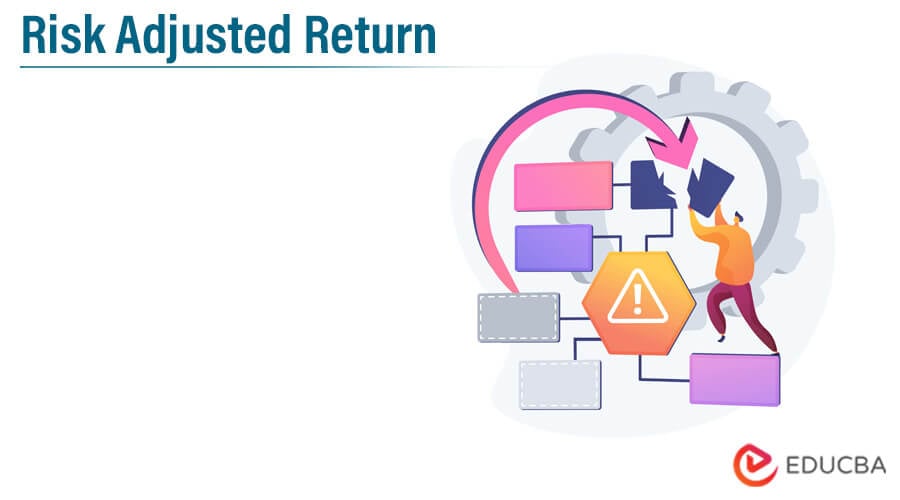Updated July 7, 2023
Definition of Risk Adjusted Return
Risk-adjusted returns eliminate the risks associated with earned returns. In this type of investment, the investor can consider risk-free or risk-adjusted returns. The risk from this investment can be compared to risk-free investments, allowing for a relatively lower level of risk.
Several approved methods exist to calculate the risk levels for this investment type, and the investor can adjust the risk according to their preference and convenience.
Explanation
Prescribed formulas calculate the risk associated with any returns and determine the rate of returns. Investors need to determine the amount of returns required from their investment in a specific stock or shares of a company. Then, they can compare the expected and required returns and assess the risk associated with this type of investment. Investors should simultaneously focus on the risk and return to earn better profits from the investments. It is always advisable for investors to keep track of the correct evaluation of the risk from the investment. Thus, they can draw a comparison between the expected returns and the required rate of return. Investors can choose from calculating methods and rely on the calculated risk to make a fair decision for the risk-adjusted return. The evaluation of the investor’s portfolio, also known as the Sharpe ratio, calculates the risk-adjusted returns of any stock.
How to Calculate Risk-Adjusted Return?
- Identify the stocks for investment.
- Compute the returns from the investment.
- Evaluate the returns obtained.
- Calculate the risk using prescribed formulas to compare two or more stocks.
- Find the risk-free rate from the stocks.
- Select Sharpe’s ratio method to determine the risk-adjusted returns.
- Calculate the Sharpe ratio for each stock.
- Assess the quality of investment in a stock based on its Sharpe ratio.
- Prioritize stocks with higher Sharpe ratios for better risk-adjusted returns.
Examples of Risk-Adjusted Return
An investor is looking for a better investment for his portfolio, and thus he has invested in two stocks, for example, to check which stock is better by comparing the risk-adjusted return of the two. The investor will be using the Sharpe Ratio to make that comparison.
The stocks are X and Y. The stock returns are 25% from X and 30% from Y. The risk-free rate is 8% in the market. The risk associated with the stocks is 10% for X and 15% for Y. The investor wants us to give him the correct risk-adjusted return calculation for both stocks so that he will make the correct decision for the same.
Solution:
| Particulars | Return (%) | Risk-Free Return | Risk (%) | Sharpe Ratio (%) |
| X | 25 | 8 | 10 | 1.70 |
| Y | 30 | 8 | 15 | 1.47 |
The Sharpe Ratio is calculated with the help of this formula:-
Sharpe Ratio = (Return – Risk Free Return) / Risk of The Stocks
In this example, stock X has more Sharpe Ratio than Stock Y. Thus the investor should consider investing in stock X if the consideration is of Risk-adjusted return of the individual stock.
Importance
- The investor should always calculate the risk-adjusted return before analyzing the investment to earn.
- The investor can make out their mind about the investment in the stock or shares, which is beneficial in the context of the risk associated with the returns.
- By calculating the risk-adjusted returns, investors can easily select the investment options that will help them calculate the risk and the returns.
- The investor will gain an idea of the investment to make, enabling them to make the correct decision.
- Investors can calculate the risk rate of their investment using the prescribed formula, ensuring they always have knowledge of their investment’s risk rate.
- The investment decision cannot be based merely on returns earned from the portfolio or stock. The decision will also depend on the risk-adjusted returns, and the investment outcome from that stock will determine the better risk-adjusted return ratio.
Advantages
- The investor can analyze the performance of the investment he will make.
- The investor can make his mind clear about the risk tolerance associated with his stock returns.
- The portfolio evaluation can be done very quickly because the risk-adjusted return will make the investor understand the better option which can be chosen if the risk-adjusted return is the metric.
- The investor can adjust their portfolio if they understand the investment policy for risk-adjusted returns.
- The stock’s performance can also be easily assessed with its help.
- It is a tool that investors use to make a good decision on investment to be made.
- The investors can test and analyze their risk tolerance level, which will help them make appropriate decisions.
Conclusion
It is a tool helping investors decide by calculating the risk-adjusted returns for each stock. Investors can understand the risk tolerance level at every stage to make a good decision regarding their investment and plan or reset their portfolio. The investor can evaluate the portfolio using the Sharpe Ratio, which tells them the risk-adjusted return of that stock.
Recommended Articles
This is a guide to Risk Adjusted Return. Here we also discuss the definition, Importance, and how to calculate risk-adjusted return along with advantages. You may also have a look at the following articles to learn more –




